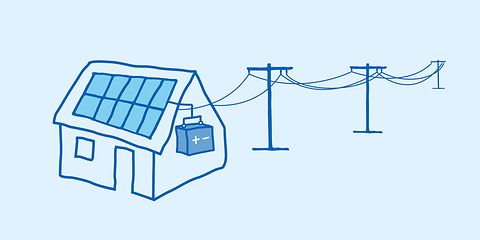

The Energy System in 2030

Our goals
We are making the energy system fit for the future: digital, flexible and reliable
- Ensure an effective interaction of systems and participants in the power grid and make optimal use of their capabilities
- Develop the Smart Metering system as a new part of the infrastructure to bring players in the system together, safely and reliably
- Monitor and maintain reliability at a constant level despite increasing complexity of the grid
We bring the energy transition to the customer
- Drive customer value for new energy world by enabling each customer to contribute to flexibility and reducing complexity in the system
- Ensure an optimal involvement of all stakeholders and accelerate the implementation through technical rules and targeted measures
- Promote standardised interfaces which are manufacturer-independent and compatible with different systems
We design a sustainable grid operation and contribute to climate neutrality
- Optimize service life and environmental sustainability of plants to be upgradable, modular and contribute to the circular economy
- Classify potential minimization of grid losses and implement sustainable path management strategies as well as improve sustainable maintenance of network equipment
- Help shape the framework:
- Contribute to European standards and solutions as a basis for the development of the power grid
- Manage and accelerate the integration of renewable energies transparently
Graphics on the action priorities
Towards a “climate protection grid” by 2030 - our roadmap
VDE FNN has defined its vision for the energy system in 2030 through a roadmap, which provides concrete details from VDE FNN continuous work and points to solutions for the challenges ahead.
Our main action points are:
- Supporting the system transformation while ensuring a secure and reliable energy supply
- Bringing the energy transition to the customer
- Developing grid operation in a climate-friendly and sustainable way
No system design without rulemaking
VDE FNN has developed the so-called "FNN Scenario" to ensure that technical regulation is developed consistently and with foresight. To this end, FNN experts regularly analyze existing scenarios and resolutions, such as the grid development plan of the Federal Network Agency, climate summits and targets for electric mobility, and develop them further. The scenario for 2030 contains concrete assumptions for system-relevant variables such as gross electricity consumption, the number of electric vehicles on the streets and the performance of storage systems and power-to-X plants. The scenario compares to data from 2018 and presents variables in different categories: generation, load, flexibility and infrastructure. The 2030 scenario lays out the assumptions onto which VDE FNN bases its work on rulemaking. This provides the energy sector with orientation as well as planning and investment security. The 2030 scenario is the basis for the work of VDE FNN together with the roadmap "From grid to system", which was presented at the 2017 congress and has been continuously implemented since then.
The VDE FNN Sensitivity column describes the topics which are influenced by the changes in the key parameters of the scenarios. Areas of work such as the regulation framework or technical requirements for e-mobility must adapt to the evolving system. VDE FNN continuously monitors these developments and proposes solutions for the energy system by 2030.
FNN Scenario 2030
2018 | 2030 | VDE FNN Sensitivity | |
RES share | 38 % | 65 %KoaV | Regulatory framework, support schemes and market incentives |
| Gross electricity consumption | 599 TWh | 590 TWh1 | Regulatory framework, support schemes and market incentives |
| SAIDI | 15 min8 | 15 min | Regulatory framework, support schemes and market incentives |
| Number of electrical vehicles | 0,054 million4 | 10 million10 | Evolution of charging power and capacity |
Generation | Regulatory framework, support schemes and market incentives | ||
| 104 GW -/+/++/+++ | 73 GW1 -/+/+/+ | |
| 120 GW +/+/+/+ 12 % | 203 GW1 ++/++/++/++ 6 % | |
Consumption | Efficiency, dissemination of new technologies, regulatory framework, support schemes, market incentives, evolution of charging performance and capacity | ||
| 79 GW11 | 81 GW2 | |
| 10 GW7 | 14 GW6 | |
| 250 MW 88%/12%9 | 10 GW 80%/20% | |
Flexibility |
| Regulatory framework, Development Technology | |
| 2 GW 80%/20% < 10% | 8 GW1 80%/20% 70% | |
| 0 GW 0%/0% | 2 GW1 20%/80% | |
| 3 GW | 18-25 GW | |
Infrastructure | |||
Communication platform rollout (Smart Metering System) | 0% | 50% |
Status: Autuum 2019
Legend
6dena
7BMWK
8BNetzA Monitoring Report 2018
10Charging infrastructure master plan
11 SMARD
KoaV Coalitions agreement 2018
CO2 price 2018: 14,80€/t CO2









